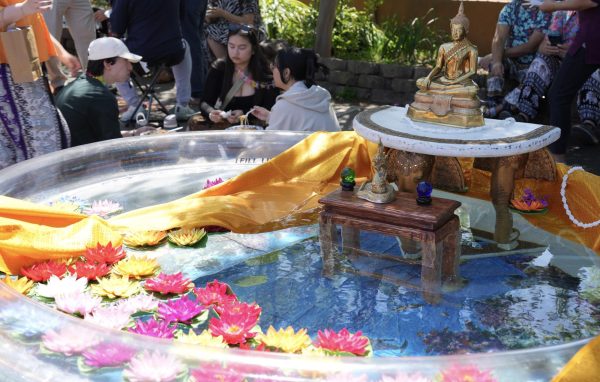The lasting impact of teachers of color on campus
Teachers and students share how teachers of color have influenced their lives
For many years, studies have shown that the presence of teachers of color has greatly improved student success rates, including high school graduation rates.
As a child growing up in a multicultural environment, Lisa Goldsmith, a biology teacher at Granite Bay High School, never felt apart from those around her because of her race.
Throughout elementary school, she was exposed to both diverse students and staff, as her school was completely bilingual, teaching all classes in both English and Spanish.
This presence of teachers of color in her life and growing up in an inclusive community in a way protected her from marginalization that she would experience later in life.
“To be completely honest, I didn’t know racism, discrimination, inequity, (and) microaggressions existed until I reached middle school,” Goldsmith said. “That may (have been) due to my age and maturity and that my focus was on toys and friends and not the greater world around me yet, but I truly appreciate that, being the only Asian student in the classroom, I never ever felt like the only Asian student in the classroom in elementary school.”
In part, Goldsmith attributed this to the fact that her adoptive parents are both white and white passing.
“I didn’t have a connection to my Korean culture until college because I wasn’t exposed to any Korean people or Asian people. I almost ‘felt’ white when I was younger because I didn’t feel or see a difference between my family, friends, and myself,” Goldsmith said.
Upon entering middle school, however, she experienced overt racism first hand as students would call out derogatory and hurtful phrases towards her.
“My gut instinct was ‘this is wrong, that was mean, my feelings are hurt’, but I couldn’t identify why because I had no one to educate me about the racism and microaggressions I may face as a person of color in my community, and why I would face those,” Goldsmith said. “I didn’t tell anyone about what happened because I thought it was an isolated issue to me (and) I didn’t have teachers of color at that age. I knew what (the students) were saying and doing was wrong, but I didn’t know it was racist…because I had no one to educate me about (racism).”
The discriminatory acts she faced as a student has allowed her to become a stronger advocate for her own students.
“My own marginalized experiences cause me to push my students to speak out and stand up for themselves or those that are marginalized. I don’t want anyone to feel silenced or that they don’t have someone to stand up for them…like I did growing up,” Goldsmith said.
Internalized racism is often a result of school systems unintentionally projecting white values onto students of color, which can greatly, negatively affect their views on their own race. In a qualitative study, co-founder of Institute for Teachers of Color Committed to Racial Justice and contributing author of Teachers of Color: Resisting Racism and Reclaiming Education Rita Kholi explained internalized racism and their dangers in the classroom. For example, a black student, now teacher, in a white majority school faced both direct and subtle forms of racism; these encounters soon caused her to look down upon other black people and communities as she began to accept the toxic perspective taught by the school.
This shines light on the importance of eliminating racial discrimination and microaggressions from the source, and preventing teachers of colors who experienced internalized racism themselves from unconsciously promoting similar racial hierarchy to their students.
In the article “Where Are All The Teachers of Color?”, published by the Harvard Graduate School of Education, author Josh Moss discussed the importance of a greater presence of minority teachers, as they “provide culturally relevant teaching, develop trusting relationships with students, confront issues of racism through teaching, and become advocates and cultural brokers.”
To Phoenix Johnson, an English teacher at GBHS, the few experiences she had with teachers of color growing up left a long-lasting impact on her life.
“There were so few (teachers of color), so when I saw (that) reflection of me, it gave me a sense of safety and security,” Johnson said. “I felt that they understood me (and) I didn’t have to fit into what I perceived my European American teachers’ …biases were and (didn’t)have to overcompensate to be recognized as just a student in the classroom. I knew that, at least in my experience with those teachers or educators (of color), because a lot of times they were very strict on me and they had high expectations.”
According to an article published by Johns Hopkins University outlining the effects of black teachers on students, black students growing up in low income households are significantly likelier to graduate high school and the probability of them dropping out is reduced by about 29% if they have at least one black teacher in elementary school.
Although any teacher, regardless of race, is capable of bringing these qualities of racial awareness and understanding to students, teachers of color are able to do this to an even greater level, through their own personal experiences.
“Many of the (teachers of color) I’ve had in the past (would) actually (reflect) on their experiences which helps students understand how racial discrimination is very much prevalent, even in 21st century first world nations,” said Shreya Reddy, a senior at GBHS. “By their willingness to discuss, students learn a lot from the experiences that they share, and can apply that in the future to help society grow.”
With this, Johnson has worked to encompass and educate herself on all different aspects of culture throughout her life, to help better the students around her.
“My mama taught me very well to be diverse in my teaching, in the look of my classroom, in the focus (of the classroom), to learn as much as I could about many cultures and faiths, and try to be respectful and bring them in to challenge us all,” Johnson said.
In regards to creating a more inclusive environment, Goldsmith noted the importance of educating the student body on what racism, other forms of discrimination is and why it is unacceptable to take part in.
“(Changes) need to start with the staff. As a staff we need to be educated not only on effective strategies to inject diversity and inclusivity into our curriculum, but the entire staff needs to be thoroughly educated on what racism is, what microaggressions are, what discrimination is, what xenophobia is, what…it looks like in the classroom, why it is wrong, and how to respond to it,” Goldsmith said.
Similarly, Johnson believes equity starts with recognizing and appreciating diversity on campus.
“I think that the best way is to just acknowledge the students that are in the room from different cultural backgrounds, different ethnic backgrounds, different faith backgrounds or lack thereof, and different gender backgrounds,” Johnson said. “I think just to recognize and acknowledge (everyone) as human beings.”

Mareesa, a senior, is one of the editors-in-chief, and this is her second year on the Gazette staff.
















Reagan Allen • Sep 17, 2021 at 10:12 am
I really like this article because it opens peoples eyes to what has been happening and that racism isn’t a new and rising thing. It also shows that not just the colored community is affected but also the asian community and maybe even hispanic. It broadens the perspective of what has been happening around the world and that it isn’t off in a far away land, it’s close to home.
Sophia Nassif • Sep 17, 2021 at 10:12 am
I definitely agree with this article and I think that this article shows how important it is to have racial awareness at school. This can teach students of color to pursue their dreams and passions even if they are a victim of racial discrimination.
Ms. Johnson • Apr 29, 2021 at 1:41 pm
Mareesa Islam”s article “The Lasting Impact of Teachers of Color on Campus” challenges our biases and gently guides the reader to the perspectives of BIPOC educators as they experienced learning by accepting teachers that reflected what they would one day become. I hope the conversation continues.
Amre Abumarkhieh • Apr 9, 2021 at 10:32 am
I definitely agree with this article. I think having racial awareness at school is important to create an inclusive environment, and it even encourages students, who often feel excluded, to continue and pursue their dreams. Overall, this article was very strong.
Taylor • Apr 9, 2021 at 10:28 am
Loved the article, so interesting!